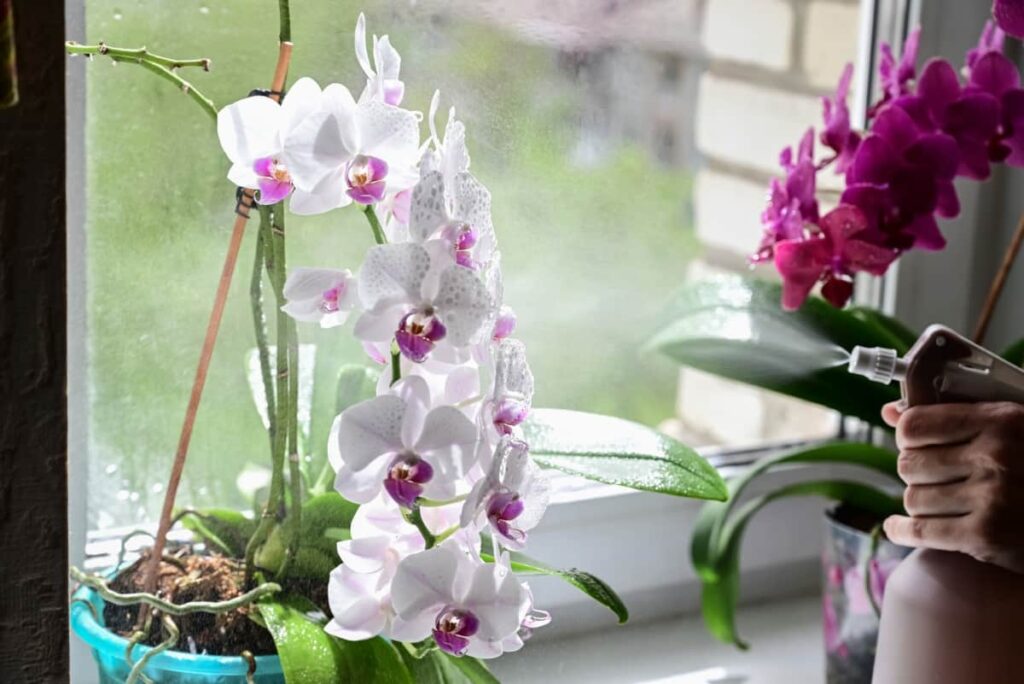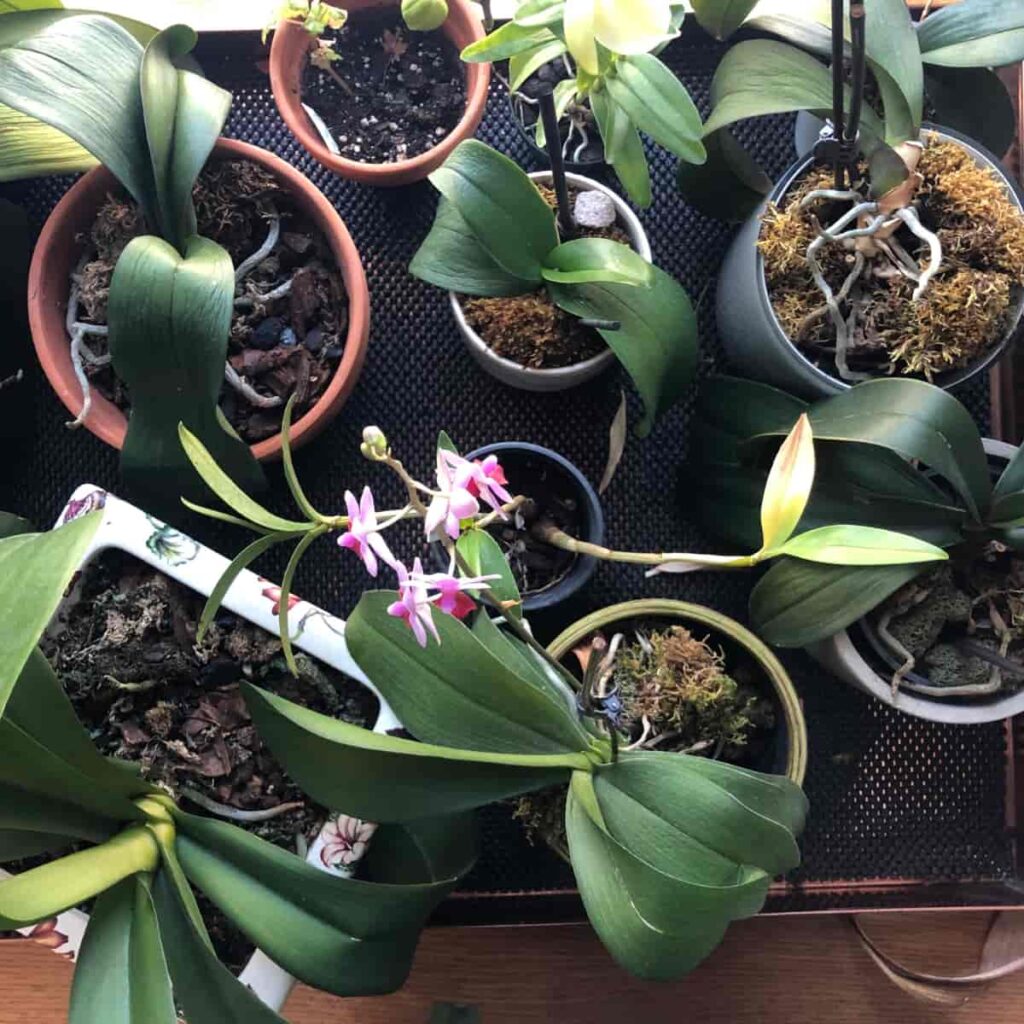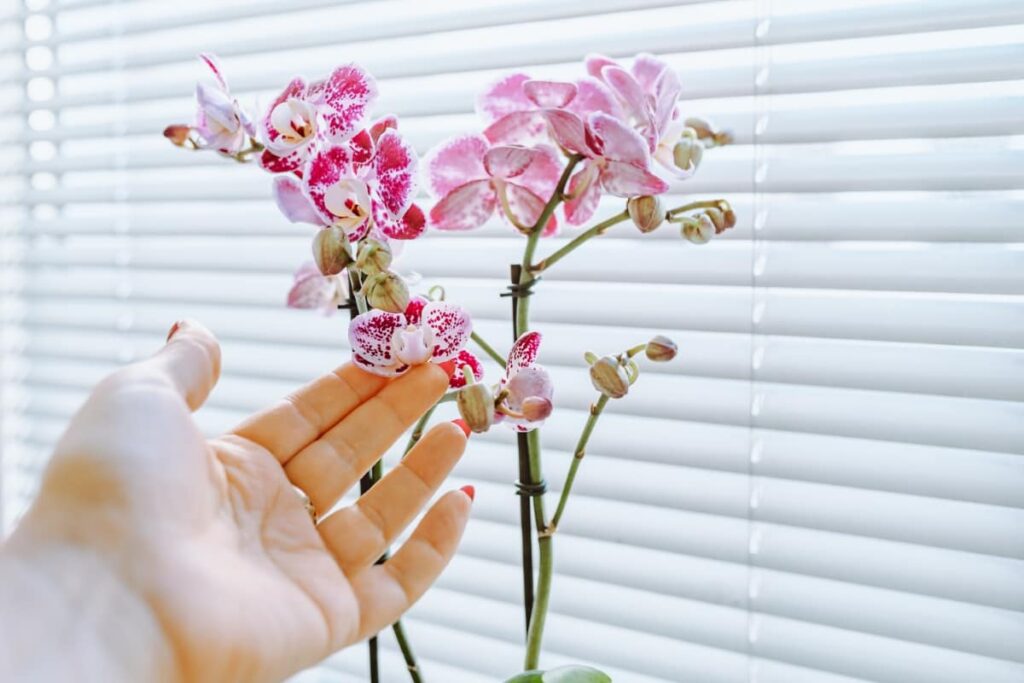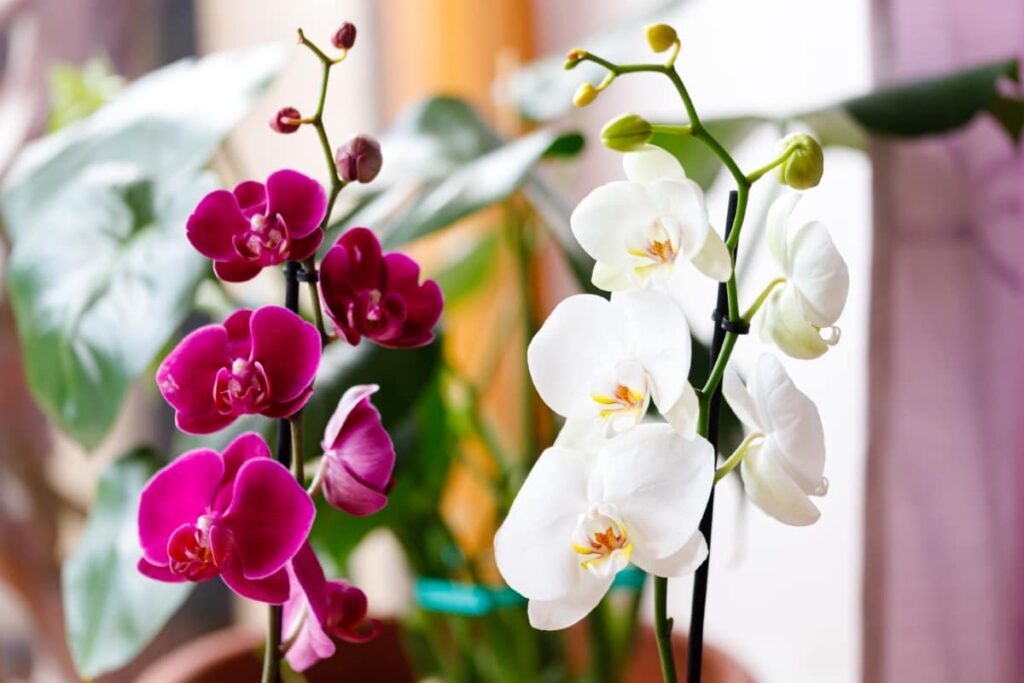Orchids are beautiful and delicate flowers belonging to the family Orchidaceae. When your Orchid fails to bloom, it can be frustrating and confusing. There are several reasons why your Orchid may not be flowering as expected. In this article, we will explain the top 10 reasons why the Orchids are not blooming and provide you with remedies to help your Orchids thrive and bloom beautifully.

10 Reasons Why My Orchids are Not Blooming
Insufficient Light
Natural Light Requirements
Finding the right balance of light for your Orchids is crucial for encouraging blooming. Orchids require a good amount of natural light to thrive, but direct sunlight can cause damage. Place your Orchid plants in a spot where they can receive bright, indirect sunlight throughout the day.
Artificial Lighting Alternatives
If natural light is limited in your place, consider using artificial lighting as an alternative. LED grow lights are popular for supplementing light requirements for Orchids. Locate the lights about 6 to 12 inches above the Orchid plants and adjust the duration based on the needs of your Orchid species. By providing adequate light, whether through natural means or artificial sources, you can help your Orchids flourish and eventually bloom beautifully.
Inappropriate Watering
Overwatering Issues
Overwatering your Orchids can lead to root rot, a common issue caused by excessive moisture. Signs of overwatering the Orchids include yellowing leaves and wilting emanating from the potting medium. To combat this problem, ensure proper drainage in your Orchid container and allow the top layer of the potting soil mix to dry out before watering again.
Underwatering Symptoms
Underwatering can also hinder blooming in Orchids. Symptoms of underwatered Orchids may include shriveled pseudobulbs, wrinkled leaves, and slow growth. It’s essential to establish a consistent watering schedule for your Orchids while considering factors like humidity levels and temperature variations. Finding the balance between overwatering and underwatering is crucial for maintaining healthy blooming Orchids.
Incorrect Humidity Levels
High Humidity Challenges
High humidity can pose challenges, such as promoting fungal growth and root rot, while low humidity can lead to dehydration and wilting. To tackle high humidity issues, ensure proper air circulation around your Orchids by using a fan or opening windows. You can also use a dehumidifier to regulate moisture levels in the air. Avoid misting your Orchids too frequently, as it may contribute to excessive humidity.
Low Humidity Solutions
If you’re dealing with low humidity, consider placing a humidifier near your Orchids or grouping them to create a microclimate with increased moisture. Another trick is using pebble trays filled with water beneath your plants to boost local humidity levels. Finding the right balance in humidity for your Orchids will not only promote healthy growth but also encourage abundant blooming in the long run.
Temperature Stress
Heat Stress Effects
Temperature is important in the blooming of Orchids. Heat stress can have detrimental effects on these delicate plants, causing wilting leaves and scorched blooms. It’s essential to protect Orchids from excessive heat by providing adequate ventilation and shade during hot summer months.
Cold Stress Signs
Cold stress can also hinder the flowering process of Orchids. Signs of cold stress include yellowing leaves, slow growth, and delayed blooming. To prevent this, it’s important to shield Orchids from cold drafts and sudden temperature drops. Maintaining a consistent temperature environment is key to promoting healthy blooming in Orchids.
Nutritional Deficiencies
Lack of Fertilization
Nutritional deficiencies can be a major reason why your Orchids are not blooming as expected. If you notice lackluster growth or faded leaves, it could be a sign that your plant is not getting the nutrients it needs to thrive. Regularly monitor your Orchid plants for any nutrient deficiency or excess signs, such as yellowing leaves or stunted growth. Adjust your fertilization routine accordingly to ensure optimal health and encourage blooming in your Orchids.
Over-Fertilization Hazards
Over-fertilization can also pose hazards to your Orchids. Too much of a good thing can lead to salt build-up in the potting medium, causing root damage and inhibiting proper nutrient absorption. Finding the right fertilizer balance is key when it comes to fertilizing Orchids. It’s essential to follow recommended guidelines for frequency and dosage based on the type of fertilizer used and the specific needs of your Orchid species.
In case you missed it: 10 Reasons Why Your Hibiscus Buds are Falling Off: Prevention and Remedies

Improper Potting Medium
Decomposed Medium Problems
Having the right potting medium for your Orchids is crucial for their overall blooming success. Improper potting medium can lead to various issues, such as decomposed medium problems that hinder proper root growth and nutrient absorption. Regularly monitor the condition of your Orchid’s potting medium and repot when needed to maintain optimal growing conditions.
Medium Aeration and Drainage
When it comes to selecting a potting soil mix, ensure it provides adequate aeration and drainage to stop waterlogging, which can result in root rot. Orchids require good air circulation around their roots to thrive, so a well-draining medium is key. Avoid using old or decomposed mediums that have lost their structure or nutrients. Opt for quality materials like bark chips, sphagnum moss, perlite, or charcoal that provide the necessary support while allowing excess water to drain away efficiently.
Lack of Rest Period
Understanding Orchid Dormancy
Understanding the concept of Orchid dormancy is crucial for encouraging blooming success. During the rest period, Orchids slow down their growth and conserve energy to prepare for future blooms.
Encouraging Bloom with Rest Periods
It involves mimicking natural conditions by adjusting watering and feeding schedules. Providing a cooler temperature at night can also signal to your Orchid that it’s time to take a break and gear up for flowering. By respecting the rest period needs of your Orchid, you’re setting the stage for vibrant blooms in the future.
Pest and Disease Infestations
Common Orchid Pests
Pest infestations can be a nightmare for Orchid enthusiasts. Common pests like aphids, spider mites, and mealybugs can wreak havoc on your precious plants. These tiny invaders feed on the sap of Orchids, causing wilting leaves and stunted growth. To prevent pest infestations, regularly inspect your Orchids for any signs of bugs or diseases. Quarantine newly acquired plants to avoid introducing pests to your existing collection. Maintain good air circulation around your Orchids to deter pests from settling in.
Disease Prevention and Treatment
The common issues that can hinder their growth are fungal infections and bacterial infections. Additionally, maintaining proper hygiene by cleaning the leaves and roots regularly can help keep diseases at bay. If you notice any disease signs on your Orchids, such as yellowing leaves or unusual spots, it’s important to act quickly. Regularly inspecting your Orchids for any signs of disease and taking prompt action will go a long way in ensuring they continue to bloom beautifully.
In case you missed it: 10 Reasons Why Your Marigold is Not Blooming: 100% Effective Solutions for Flowering Issues in Marigold Plant

Age and Maturity
Juvenile Orchids
Age and maturity play a significant role in the Orchid blooming cycle. Juvenile Orchids often require time to reach maturity before they can produce beautiful blooms. As Orchids grow and develop, they go through different stages of life, each contributing to their ability to bloom.
Maturity and Blooming Cycles
Mature Orchids are more likely to bloom regularly as they have established strong root systems and developed the necessary energy reserves for flowering. Understanding the blooming cycles of different Orchid species is essential in providing them with the care they need at each stage of growth. For some Orchids, reaching maturity may take several years, while others may bloom sooner, depending on their characteristics.
Environmental Stress
Sudden Environmental Changes
Environmental stress can significantly impact the blooming of your Orchids. Sudden changes in temperature, light exposure, or humidity levels can throw off their delicate balance. Orchids are sensitive plants that require stable environmental conditions to thrive and bloom beautifully.
Adapting to New Environments
When moving your Orchid to a new environment, it’s important to acclimate them gradually. Pay attention to any stress signs, such as yellowing leaves, wilting flowers, or stunted growth. These could be indicators that your Orchid is struggling to adapt. By monitoring their response and making necessary adjustments, you can help them overcome environmental challenges and encourage blooming.
In case you missed it: 10 Reasons Why Your Lotus Plant is Not Blooming: 100% Effective Solutions for Flowering Issues in Lotus

Conclusion
Orchids are stunning plants that captivate with their vibrant blooms, but sometimes, the Orchids are not flowering. Orchid blooming issues can stem from various factors, ranging from light and water conditions to nutrition and environmental stress. Understanding the reasons behind why your Orchids may not be blooming is essential in helping them thrive.
- Management Pests and Diseases in Your Cotton Field
- Sheep Farming Business Plan for Beginners
- Aquaponic Farming at Home: A Step-By-Step Guide
- Profitable Village Farming Business Ideas in 2024
- High-Yield Aquaculture: Fast-Growing Fish for Farming
- Effective Fish Pond Construction Techniques for Beginners
- Irrigation and Water Management in Pineapple Farming
- Blossom to Harvest: Mastering Flowering and Pollination in Papaya Farming
- Pig Fattening Essentials: From Selection to Sale for Beginners
